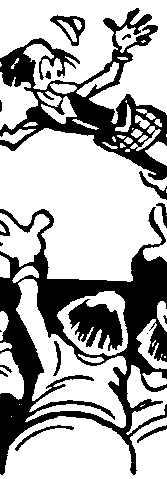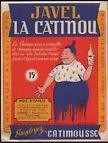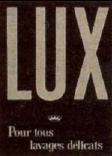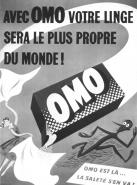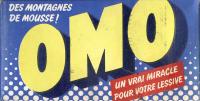Notes on and quotations from Roland Barthes
Lectures pour tous (Barthes on TV)
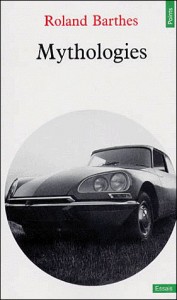
|
Barthes, R. 1957 Mythologies Seuil: Paris 1957.
Cover shows a picture of the
"new Citroen" launched in October 1955
In French fifty-four articles written between 1952 and 1956, mainly for the left-wing magazine Les Lettres nouvelles. These were mostly from Barthe's small mythologies of the month series. The selected articles were followed by a retrospective theoretical article on myth today. Selections were translated into English by Annette Lavers as Mythologies (Cape) in 1972. |
Le monde où l'on catche [The World of Wrestling] appeared in Esprit in October 1952.
Jules César au cinéma was in Lettres
nouvelles in January 1954. In Mythologies it was given the English
title
The Romans in Films
L'écrivain en vacances (The writer on holiday) was in
France-Observateur 9.9.1954.
"Petite mythologie du mois" [Small mythologies of the month articles] in
Lettres nouvelles
November 1954: - Martiens - La croisière du
sang bleu [The 'Blue Blood' Cruise] - Critique muette et aveugle [Blind and
Dumb Criticism] - Saponides et détergents
[Soap-powders and Detergents]
-
Le pauvre et le prolétaire [The Poor and the Proletariat].
December 1954: - Mythologie perpétuelle - Les
Martiens et la presse - Les Martiens et l'église - Nouvelles
mystifications - L'opération Astra [Operation Margarine] -
Conjugales -
Phénomène de mythe?
23 January 1955: - Dominici ou le triomphe de la
littérature [Dominici, or the Triumph of Literature] - Iconographie
de l'abbé Pierre [The Iconography of the Abbé Pierre] -
Romans et
enfants
[Novels and Children] - Matisse et le bonheur de vivre
February 1955: - Pour une histoire de l'enfance -
Enfants-Vedettes - Enfants-Copies -
Jouets
[Toys].
March 1955: - Paris n'a pas été
inondé - Bichon chez les nègres - La vaccine de l'avant-garde
-
Comment démystifier - Un ouvrier sympathique.
April 1955: -
Le visage de Garbo [The Face of Garbo] - Puissance et
désinvolture -
Le vin et le lait [Wine and Milk] - Le beefsteack et les frites.
[Steak and Chips]
May 1955: - Nautilus et le bateau ivre
[The Nautilus and the Drunken Boat]
-
Publicité de la profondeur - Quelques paroles de
M. Poujade - Adamov et le langage
June 1955: -
Le cerveau d'Einstein The Brain of Einstein -
L'homme-jet [The Jet-man] -
Le Group Captain Townsend - Racine
est Racine.
July August 1955 -
Billy Graham au Vel'd'Hiv'-
Le procès Dupriez -
Photos-chocs -
Deux mythes du jeune théâtre
- Suis-je marxiste?
September 1955 Le Tour de France comme épopée
October 1955
Le Guide bleu [The Blue Guide] -
Celle qui voit clair -
Cuisine ornementale [Ornamental Cookery] -
La croisière du Batory
November 1955 -
L'usager et la grève -
Lexique marocain and Grammaire
marocaine [In Mythologies as Grammaire
africaine]
December 1955 -
Strip-tease [Striptease] - La critique Ni-Ni [Neither-Nor Criticism] -
La nouvelle
Citroën [The New Citroën]
February 1956: -
Photogénie électorale [Photography and Electoral
Appeal. Includes only mention of television] -
Continent perdu [The Lost Continent] - Astrologie - L'art vocal bourgeois
March 1956 -
Le plastique [Plastic] -
La grande famille des hommes [The Great Family of Man] -
Au music-hall
April 1956 - Poujade et les intellectuels
May 1956 - La Dame aux camélias [The Lady of the Camellias].

|
Karl Von Hess (USA c.1919 - 12,8.2009)
and Félix Miquet (France: 10.10.1908 - 8.3.1987) |
1949? Félix Miquet and Ivar Martison wrestling at the Vel D'Hive in Paris.
|
Pierre Desgraupes Yes, that is, you write in your book that wrestling is made to express a certain idea of justice somehow. Roland Barthes Exactly. |
Pages 15 to 25 of 1972 printed edition. Pages 13 to 23 of an electronic edition.
THE WORLD OF WRESTLING
The grandiloquent truth of gestures
on life's great occasions.
Baudelaire
The virtue of all-in wrestling is that it is the spectacle of excess. Here we find a grandiloquence which must have been that of ancient theaters. And in fact wrestling is an open-air spectacle, for what makes the circus or the arena what they are is not the sky (a romantic value suited rather to fashionable occasions), it is the drenching and vertical quality of the flood of light. Even hidden in the most squalid Parisian halls, wrestling partakes of the nature of the great solar spectacles, Greek drama and bullfights: in both, a light without shadow generates an emotion without reserve.
There are people who think that wrestling is an ignoble sport. Wrestling is not a sport, it is a spectacle, and it is no more ignoble to attend a wrestled performance of Suffering than a performance of the sorrows of Arnolphe or Andromaque.* Of course, there exists a false wrestling, in which the participants unnecessarily go to great lengths to make a show of a fair fight; this is of no interest. True wrestling, wrongly called amateur wrestling, is performed in second-rate halls, where the public spontaneously attunes itself to the spectacular nature of the contest, like the audience at a suburban cinema. Then these same people wax indignant because wrestling is a stage-managed sport (which ought, by the way, to mitigate its ignominy). The public is completely uninterested in knowing whether the contest is rigged or not, and rightly so; it abandons itself to the primary virtue of the spectacle, which is to abolish all motives and all consequences: what matters is not what it thinks but what it sees.
This public knows very well the distinction between wrestling and boxing; it knows that boxing is a Jansenist sport, based on a demonstration of excellence. One can bet on the outcome of a boxing-match: with wrestling, it would make no sense. A boxing- match is a story which is constructed before the eyes of the spectator; in wrestling, on the contrary, it is each moment which is intelligible, not the passage of time. The spectator is not interested in the rise and fall of fortunes; he expects the transient image of certain passions. Wrestling therefore demands an immediate reading of the juxtaposed meanings, so that there is no need to connect them. The logical conclusion of the contest does not interest the wrestling-fan, while on the contrary a boxing-match always implies a science of the future. In other words, wrestling is a sum of spectacles, of which no single one is a function: each moment imposes the total knowledge of a passion which rises erect and alone, without ever extending to the crowning moment of a result.
Thus the function of the wrestler is not to win; it is to go exactly through the motions which are expected of him. It is said that judo contains a hidden symbolic aspect; even in the midst of efficiency, its gestures are measured, precise but restricted, drawn accurately but by a stroke without volume. Wrestling, on the contrary, offers excessive gestures, exploited to the limit of their meaning. In judo, a man who is down is hardly down at all, he rolls over, he draws back, he eludes defeat, or, if the latter is obvious, he immediately disappears; in wrestling, a man who is down is exaggeratedly so, and completely fills the eyes of the spectators with the intolerable spectacle of his powerlessness.
This function of grandiloquence is indeed the same as that of ancient theater, whose principle, language and props (masks and buskins) concurred in the exaggeratedly visible explanation of a Necessity. The gesture of the vanquished wrestler signifying to the world a defeat which, far from disguising, he emphasizes and holds like a pause in music, corresponds to the mask of antiquity meant to signify the tragic mode of the spectacle. In wrestling, as on the stage in antiquity, one is not ashamed of one's suffering, one knows how to cry, one has a liking for tears.
Each sign in wrestling is therefore endowed with an absolute clarity, since one must always understand everything on the spot. As soon as the adversaries are in the ring, the public is overwhelmed with the obviousness of the roles. As in the theater, each physical type expresses to excess the part which has been assigned to the contestant. Thauvin, a fifty-year-old with an obese and sagging body, whose type of asexual hideousness always inspires feminine nicknames, displays in his flesh the characters of baseness, for his part is to represent what, in the classical concept of the salaud, the 'bastard' (the key-concept of any wrestling-match), appears as organically repugnant. The nausea voluntarily provoked by Thauvin shows therefore a very extended use of signs: not only is ugliness used here in order to signify baseness, but in addition ugliness is wholly gathered into a particularly repulsive quality of matter: the pallid collapse of dead flesh (the public calls Thauvin la barbaque, 'stinking meat'), so that the passionate condemnation of the crowd no longer stems from its judgment, but instead from the very depth of its humours. It will thereafter let itself be frenetically embroiled in an idea of Thauvin which will conform entirely with this physical origin: his actions will perfectly correspond to the essential viscosity of his personage.
It is therefore in the body of the wrestler that we find the first key to the contest. I know from the start that all of Thauvin's actions, his treacheries, cruelties and acts of cowardice, will not fail to measure up to the first image of ignobility he gave me; I can trust him to carry out intelligently and to the last detail all the gestures of a kind of amorphous baseness, and thus fill to the brim the image of the most repugnant bastard there is: the bastard-octopus. Wrestlers therefore have a physique as peremptory as those of the characters of the Commedia dell'Arte, who display in advance, in their costumes and attitudes, the future contents of their parts: just as Pantaloon can never be anything but a ridiculous cuckold, Harlequin an astute servant and the Doctor a stupid pedant, in the same way Thauvin will never be anything but an ignoble traitor, Reinieres (a tall blond fellow with a limp body and unkempt hair) the moving image of passivity, Mazaud (short and arrogant like a cock) that of grotesque conceit, and Orsano (an effeminate teddy-boy first seen in a blue- and-pink dressing-gown) that, doubly humorous, of a vindictive salope, or bitch (for I do not think that the public of the Elysee- Montmartre, like Littre, believes the word "salope" to be a masculine).
The physique of the wrestlers therefore constitutes a basic sign, which like a seed contains the whole fight. But this seed proliferates, for it is at every turn during the fight, in each new situation, that the body of the wrestler casts to the public the magical entertainment of a temperament which finds its natural expression in a gesture. The different strata of meaning throw light on each other, and form the most intelligible of spectacles. Wrestling is like a diacritic writing: above the fundamental meaning of his body, the wrestler arranges comments which are episodic but always opportune, and constantly help the reading of the fight by means of gestures, attitudes and mimicry which make the intention utterly obvious. Sometimes the wrestler triumphs with a repulsive sneer while kneeling on the good sportsman; sometimes he gives the crowd a conceited smile which forebodes an early revenge; sometimes, pinned to the ground, he hits the floor ostentatiously to make evident toall the intolerable nature of his situation; and sometimes he erects a complicated set of signs meant to make the public understand that he legitimately personifies the ever- entertaining image of the grumbler, endlessly confabulating about his displeasure.
We are therefore dealing with a real Human Comedy, where the most socially- inspired nuances of passion (conceit, rightfulness, refined cruelty, a sense of 'paying one's debts') always felicitously find the clearest sign which can receive them, express them and triumphantly carry them to the confines of the hall. It is obvious that at such a pitch, it no longer matters whether the passion is genuine or not. What the public wants is the image of passion, not passion itself. There is no more a problem of truth in wrestling than in the theater. In both, what is expected is the intelligible representation of moral situations which are usually private. This emptying out of interiority to the benefit of its exterior signs, this exhaustion of the content by the form, is the very principle of triumphant classical art. Wrestling is an immediate pantomime, infinitely more efficient than the dramatic pantomime, for the wrestler's gesture needs no anecdote, no decor, in short no transference in order to appear true.
Each moment in wrestling is therefore like an algebra which instantaneously unveils the relationship between a cause and its represented effect. Wrestling fans certainly experience a kind of intellectual pleasure in seeing the moral mechanism function so perfectly. Some wrestlers, who are great comedians, entertain as much as a Moliere character, because they succeed in imposing an immediate reading of their inner nature: Armand Mazaud, a wrestler of an arrogant and ridiculous character (as one says that Harpagon** is a character), always delights the audience by the mathematical rigor of his transcriptions, carrying the form of his gestures to the furthest reaches of their meaning, and giving to his manner of fighting the kind of vehemence and precision found in a great scholastic disputation, in which what is at stake is at once the triumph of pride and the formal concern with truth.
What is thus displayed for the public is the great spectacle of Suffering, Defeat, and Justice. Wrestling presents man's suffering with all the amplification of tragic masks. The wrestler who suffers in a hold which is reputedly cruel (an arm- lock, a twisted leg) offers an excessive portrayal of Suffering; like a primitive Pieta, he exhibits for all to see his face, exaggeratedly contorted by an intolerable affliction. It is obvious, of course, that in wrestling reserve would be out of place, since it is opposed to the voluntary ostentation of the spectacle, to this Exhibition of Suffering which is the very aim of the fight. This is why all the actions which produce suffering are particularly spectacular, like the gesture of a conjuror who holds out his cards clearly to the public. Suffering which appeared without intelligible cause would not be understood; a concealed action that was actually cruel would transgress the unwritten rules of wrestling and would have no more sociological efficacy than a mad or parasitic gesture. On the contrary suffering appears as inflicted with emphasis and conviction, for everyone must not only see that the man suffers, but also and above all understand why he suffers. What wrestlers call a hold, that is, any figure which allows one to immobilize the adversary indefinitely and to have him at one's mercy, has precisely the function of preparing in a conventional, therefore intelligible, fashion the spectacle of suffering, of methodically establishing the conditions of suffering. The inertia of the vanquished allows the (temporary) victor to settle in his cruelty and to convey to the public this terrifying slowness of the torturer who is certain about the outcome of his actions; to grind the face of one's powerless adversary or to scrape his spine with one's fist with a deep and regular movement, or at least to produce the superficial appearance of such gestures: wrestling is the only sport which gives such an externalized image of torture. But here again, only the image is involved in the game, and the spectator does not wish for the actual suffering of the contestant; he only enjoys the perfection of an iconography. It is not true that wrestling is a sadistic spectacle: it is only an intelligible spectacle.
There is another figure, more spectacular still than a hold; it is the forearm smash, this loud slap of the forearm, this embryonic punch with which one clouts the chest of one's adversary, and which is accompanied by a dull noise and the exaggerated sagging of a vanquished body. In the forearm smash, catastrophe is brought to the point of maximum obviousness, so much so that ultimately the gesture appears as no more than a symbol; this is going too far, this is transgressing the moral rules of wrestling, where all signs must be excessively clear, but must not let the intention of clarity be seen. The public then shouts 'He's laying it on!', not because it regrets the absence of real suffering, but because it condemns artifice: as in the theater, one fails to put the part across as much by an excess of sincerity as by an excess of formalism.
We have already seen to what extent wrestlers exploit the resources of a given physical style, developed and put to use in order to unfold before the eyes of the public a total image of Defeat. The flaccidity of tall white bodies which collapse with one blow or crash into the ropes with arms flailing, the inertia of massive wrestlers rebounding pitiably off all the elastic surfaces of the ring, nothing can signify more clearly and more passionately the exemplary abasement of the vanquished. Deprived of all resilience, the wrestler's flesh is no longer anything but an unspeakable heap spread out on the floor, where it solicits relentless reviling and jubilation. There is here a paroxysm of meaning in the style of antiquity, which can only recall the heavily underlined intentions in Roman triumphs. At other times, there is another ancient posture which appears in the coupling of the wrestlers, that of the suppliant who, at the mercy of his opponent, on bended knees, his arms raised above his head, is slowly brought down by the vertical pressure of the victor. In wrestling, unlike judo, Defeat is not a conventional sign, abandoned as soon as it is understood; it is not an outcome, but quite the contrary, it is a duration, a display, it takes up the ancient myths of public Suffering and Humiliation: the cross and the pillory. It is as if the wrestler is crucified in broad daylight and in the sight of all. I have heard it said of a wrestler stretched on the ground: 'He is dead, little Jesus, there, on the cross,' and these ironic words revealed the hidden roots of a spectacle which enacts the exact gestures of the most ancient purifications.
But what wrestling is above all meant to portray is a purely moral concept: that of justice. The idea of 'paying' is essential to wrestling, and the crowd's 'Give it to him' means above all else 'Make him pay'. This is therefore, needless to say, an immanent justice. The baser the action of the 'bastard', the more delighted the public is by the blow which he justly receives in return. If the villain--who is of course a coward-- takes refuge behind the ropes, claiming unfairly to have a right to do so by a brazen mimicry, he is inexorably pursued there and caught, and the crowd is jubilant at seeing the rules broken for the sake of a deserved punishment. Wrestlers know very well how to play up to the capacity for indignation of the public by presenting the very limit of the concept of Justice, this outermost zone of confrontation where it is enough to infringe the rules a little more to open the gates of a world without restraints. For a wrestling-fan, nothing is finer than the revengeful fury of a betrayed fighter who throws himself vehemently not on a successful opponent but on the smarting image of foul play. Naturally, it is the pattern of Justice which matters here, much more than its content: wrestling is above all a quantitative sequence of compensations (an eye for an eye, a tooth for a tooth). This explains why sudden changes of circumstances have in the eyes of wrestling habitues a sort of moral beauty: they enjoy them as they would enjoy an inspired episode in a novel, and the greater the contrast between the success of a move and the reversal of fortune, the nearer the good luck of a contestant to his downfall, the more satisfying the dramatic mime is felt to be. Justice is therefore the embodiment of a possible transgression; it is from the fact that there is a Law that the spectacle of the passions which infringe it derives its value.
It is therefore easy to understand why out of five wrestling matches, only about one is fair. One must realize, let it be repeated, that 'fairness' here is a role or a genre, as in the theater: the rules do not at all constitute a real constraint; they are the conventional appearance of fairness. So that in actual fact a fair fight is nothing but an exaggeratedly polite one: the contestants confront each other with zeal, not rage; they can remain in control of their passions, they do not punish their beaten opponent relentlessly, they stop fighting as soon as they are ordered to do so, and congratulate each other at the end of a particularly arduous episode, during which, however, they have not ceased to be fair. One must of course understand here that all these polite actions are brought to the notice of the public by the most conventional gestures of fairness: shaking hands, raising the arms, ostensibly avoiding a fruitless hold which would detract from the perfection of the contest.
Conversely, foul play exists only in its excessive signs: administering a big kick to one's beaten opponent, taking refuge behind the ropes while ostensibly invoking a purely formal right, refusing to shake hands with one's opponent before or after the fight, taking advantage of the end of the round to rush treacherously at theadversary from behind, fouling him while the referee is not looking (a move which obviously only has any value or function because in fact half the audience can see it and get indignant about it). Since Evil is the natural climate of wrestling, a fair fight has chiefly the value of being an exception. It surprises the aficionado, who greets it when he sees it as an anachronism and a rather sentimental throwback to the sporting tradition ('Aren't they playing fair, those two'); he feels suddenly moved at the sight of the general kindness of the world, but would probably die of boredom and indifference if wrestlers did not quickly return to the orgy of evil which alone makes good wrestling.
Extrapolated, fair wrestling could lead only to boxing or judo, whereas true wrestling derives its originality from all the excesses which make it a spectacle and not a sport. The ending of a boxing-match or a judo-contest is abrupt, like the full stop which closes a demonstration. The rhythm of wrestling is quite different, for its natural meaning is that of rhetorical amplification: the emotional magniloquence, the repeated paroxysms, the exasperation of the retorts can only find their natural outcome in the most baroque confusion. Some fights, among the most successful kind, are crowned by a final charivari, a sort of unrestrained fantasia where the rules, the laws of the genre, the referee's censuring and the limits of the ring are abolished, swept away by a triumphant disorder which overflows into the hall and carries off pell-mell wrestlers, seconds, referee and spectators.
It has already been noted that in America wrestling represents a sort of mythological fight between Good and Evil (of a quasi-political nature, the 'bad' wrestler always being supposed to be a Red). The process of creating heroes in French wrestling is very different, being based on ethics and not on politics. What the public is looking for here is the gradual construction of a highly moral image: that of the perfect 'bastard'. One comes to wrestling in order to attend the continuing adventures of a single major leading character, permanent and multiform like Punch or Scapino, inventive in unexpected figures and yet always faithful to his role. The 'bastard' is here revealed as a Moliere character or a 'portrait' by La Bruyere, that is to say as a classical entity, an essence, whose acts are only significant epiphenomena arranged in time. This stylized character does not belong to any particular nation or party, and whether the wrestler is called Kuzchenko (nicknamed Moustache after Stalin), Yerpazian, Gaspardi, Jo Vignola or Nollieres, the aficionado does not attribute to him any country except 'fairness'--observing the rules.
What then is a 'bastard' for this audience composed in part, we are told, of people who are themselves outside the rules of society ? Essentially someone unstable, who accepts the rules only when they are useful to him and transgresses the formal continuity of attitudes. He is unpredictable, therefore asocial. He takes refuge behind the law when he considers that it is in his favor, and breaks it when he finds it useful to do so. Sometimes he rejects the formal boundaries of the ring and goes on hitting an adversary legally protected by the ropes, sometimes he reestablishes these boundaries and claims the protection of what he did not respect a few minutes earlier. This inconsistency, far more than treachery or cruelty, sends the audience beside itself with rage: offended not in its morality but in its logic, it considers the contradiction of arguments as the basest of crimes. The forbidden move becomes dirty only when it destroys a quantitative equilibrium and disturbs the rigorous reckoning of compensations; what is condemned by the audience is not at all the transgression of insipid official rules, it is the lack of revenge, the absence of a punishment. So that there is nothing more exciting for a crowd than the grandiloquent kick given to a vanquished 'bastard'; the joy of punishing is at its climax when it is supported by a mathematical justification; contempt is then unrestrained. One is no longer dealing with a salaud but with a salope--the verbal gesture of the ultimate degradation.
Such a precise finality demands that wrestling should be exactly what the public expects of it. Wrestlers, who are very experienced, know perfectly how to direct the spontaneous episodes of the fight so as to make them conform to the image which the public has of the great legendary themes of its mythology. A wrestler can irritate or disgust, he never disappoints, for he always accomplishes completely, by a progressive solidification of signs, what the public expects of him. In wrestling, nothing exists except in the absolute, there is no symbol, no allusion, everything is presented exhaustively. Leaving nothing in the shade, each action discards all parasitic meanings and ceremonially offers to the public a pure and full signification, rounded like Nature. This grandiloquence is nothing but the popular and age-old image of the perfect intelligibility of reality. What is portrayed by wrestling is therefore an ideal understanding of things; it is the euphoria of men raised for a while above the constitutive ambiguity of everyday situations and placed before the panoramic view of a univocal Nature, in which signs at last correspond to causes, without obstacle, without evasion, without contradiction.
When the hero or the villain of the drama, the man who was seen a few minutes earlier possessed by moral rage, magnified into a sort of metaphysical sign, leaves the wrestling hall, impassive, anonymous, carrying a small suitcase and arm-in-arm with his wife, no one can doubt that wrestling holds that power of transmutation which is common to the Spectacle and to Religious Worship. In the ring, and even in the depths of their voluntary ignominy, wrestlers remain gods because they are, for a few moments, the key which opens Nature, the pure gesture which separates Good from Evil, and unveils the form of a Justice which is at last intelligible.
*In Moliere's L'Ecole des Femmes and Racine's Andromaque.
**In Moliere's L'Avare.
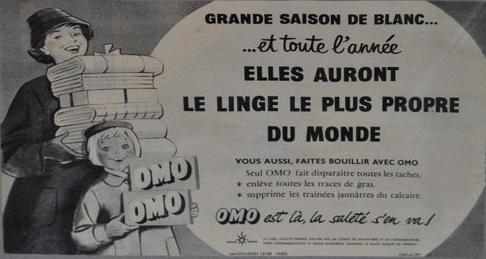
|
| In the war, the US Navy sought artificial soaps that could lather and wash in seawater, creating synthetic detergents. Most of France has hard water so that soap produces insoluble calcium deposits. France was, therefore, a natural market for foamy detergents. "Especially as in 1952, its chemical industry was able to provide the basic elements of these products." |
pages 35-37
Soap-powders and Detergents
The first World Detergent Congress (Paris, September 1954) had the effect of authorizing the world to yield to Omo euphoria: not only do detergents have no harmful effect on the skin, but they can even perhaps save miners from silicosis. These products have been in the last few years the object of such massive advertising that they now belong to a region of French daily life which the various types of psycho-analysis would do well to pay some attention to if they wish to keep up to date.
Chlorinated fluids, for instance, have always been experienced as a sort of liquid fire, the action of which must be carefully estimated, otherwise the object itself would be affected, 'burnt'. The implicit legend of this type of product rests on the idea of a violent, abrasive modification of matter: the connotations are of a chemical or mutilating type: the product 'kills' the dirt.
But even in the category of powders, one must in addition oppose against advertisements based on psychology those based on psycho-analysis (I use this word without reference to any specific school). 'Persil Whiteness' for instance, bases its prestige on the evidence of a result; it calls into play vanity, a social concern with appearances, by offering for comparison two objects, one of which is whiter than the other. Advertisements for Omo also indicate the effect of the product (and in superlative fashion, incidentally), but they chiefly reveal its mode of action; in doing so, they involve the consumer in a kind of direct experience of the substance, make him the accomplice of a liberation rather than the mere beneficiary of a result; matter here is endowed with value-bearing states.
|
Omo uses two of these, which are rather novel in the category of detergents: the deep and the foamy. To say that Omo cleans in depth (see the Cinéma-Publicité advertisement) is to assume that linen is deep, which no one had previously thought, and this unquestionably results in exalting it, by establishing it as an object favourable to those obscure tendencies to enfold and caress which are found in every human body. As for foam, it is well known that it signifies luxury. To begin with, it appears to lack any usefulness; then, its abundant, easy, almost infinite proliferation allows one to suppose there is in the substance from which it issues a vigorous germ, a healthy and powerful essence, a great wealth of active elements in a small original volume.
Omo: le linge le plus propre du monde
OMO: the cleanest laundry of the world
Est un produit Lever
Avec Persil votre linge est plus blanc parce qu'il est plus propre
With Persil your linen is white because it is cleaner
Est un produit Lever
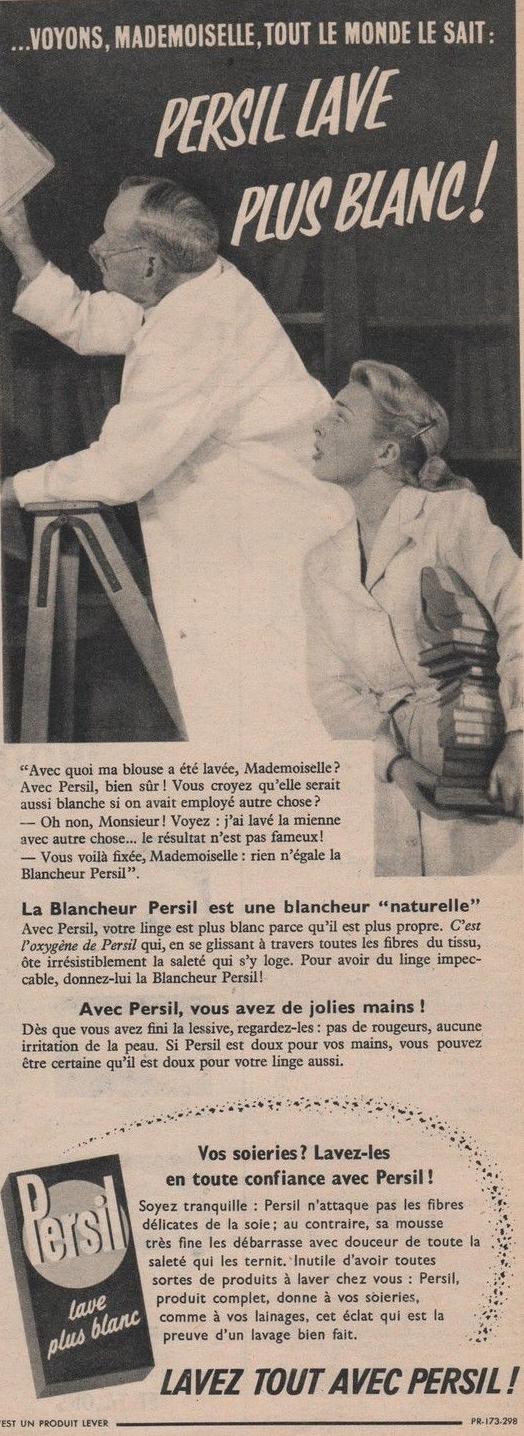
|
Le premier Congrès Mondial de la Détergence (Paris, septembre 1954) a autorisé le monde à se laisser aller à l'euphorie d'Omo : non seulement les produits détergents n'ont aucune action nocive sur la peau, mais même ils peuvent peut- être sauver les mineurs de la silicose. Or ces produits sont depuis quelques années l'objet d'une publicité si massive, qu'ils font aujourd'hui partie de cette de la vie quotidienne des Français, où les psychanalyse, si elles se tenaient à jour, devraient bien porter un peu leur regard. On pourrait alors utilement opposer à la psychanalyse des liquides purificateurs (Javel), celle des poudres saponidées (Lux, Persil) ou détergentes (Rai, Paic, Crio, Omo). Les rapports du remède et du mal, du produit et de la saleté sont très différents dans l'un ou l'autre cas.
Par exemple, les eaux de Javel ont toujours été senties comme une sorte de feu liquide dont l'action doit être soigneusement mesurée faute de quoi l'objet lui-même est atteint, " brûlé " ; la légende implicite de ce genre de produits repose sur l'idée d'une modification violente, abrasive de la matière : les répondants sont d'ordre chimique ou abrasive de la matière : le produit " tue " la saleté. Au contraire les poudres sont des éléments séparateurs ; leur rôle idéal est de libérer l'objet de son imperfection circonstancielle : on " chasse " la saleté, on ne la tue plus ; dans l'imagerie Omo, la saleté est un petit ennemi malingre et noir qui s'enfuit à toutes jambes du beau linge pur, rien qu'à la menace du jugement d'Omo. Les chlores et les ammoniaques sont sans aucun doute les délégués d'une sorte de feu total, sauveur mais aveugle ; les poudres sont au contraire sélectives, elles poussent, conduisent la saleté à travers la trame de l'objet, elles ont une fonction de police, non de guerre. Cette distinction a ses répondants ethnographiques : le liquide chimique prolonge le geste de la lavandière battant son linge, et les poudres remplacent plutôt celui de la ménagère pressant et roulant la lessive le long du lavoir incliné.
Mais dans l'ordre même des poudres, il faut encore opposer à la publicité psychologique, la publicité psychanalytique (j'entends ce mot sans y attacher une signification d'école particulière). Par exemple, la Blancheur Persil fonde son prestige sur l'évidence d'un résultat ; on met en mouvement la vanité, le paraître social, en donnant à comparer deux objets dont l'un est plus blanc que l'autre. La publicité Omo indique aussi l'effet du produit (sous une forme d'ailleurs superlative), mais surtout découvre le procès de son action ; elle engage ainsi le consommateur dans une sorte de mode vécu de la substance, le rend complice d'une délivrance et non plus seulement bénéficiaire d'un résultat ; la matière est ici pourvue d'états-valeurs.
Omo en utilise deux, assez nouveaux dans l'ordre des détergents : le profond et le mousseux. Dire qu'Omo nettoie en profondeur (voir la saynète du Cinéma-Publicité), c'est supposer que le linge est profond, magnifier, l'établir comme un objet flatteur à ces obscures poussées d'enveloppement et de caresse qui sont dans tout corps humain. Quant à la mousse, sa signification de luxe est bien connue : d'abord, elle a une apparence d'inutilité ; ensuite sa prolifération abondante, facile, infinie presque, laisse supposer dans la substance dont elle sort, un germe vigoureux, une essence saine et puissante, une grande richesse d'élément actifs sous un petit volume originel ; enfin elle flatte chez le consommateur une imagination aérienne de la matière, un mode de contact à la fois léger et vertical, poursuivi comme un bonheur aussi bien dans l'ordre gustatif (foies gras, entremets, vins) que dans celui des vêtement (mousselines, tulles) et dans celui des savons (vedette prenant son bain). La mousse peut même être signe d'une certaine spiritualité, dans la mesure où l'esprit est réputé pouvoir tirer tout de rien, une grande surface d'effets d'un petit volume de causes (les crèmes ont une tout autre psychanalyse, d'ordre sopitif : elles abolissent les rides, la douleur, le feu, etc.). L'important, c'est d'avoir su masquer la fonction abrasive de détergent sous l'image délicieuse d'une substance à la fois profonde et aérienne qui peut régir l'ordre moléculaire du tissu sans l'attaquer. Euphorie qui ne doit d'ailleurs pas faire oublier qu'il y a un plan où Persil et Omo, c'est tout comme : le plan du trust anglo-hollandais Unilever.
French toys: one could not find a better illustration of the fact that the adult Frenchman sees the child as another self. All the toys one commonly sees are essentially a microcosm of the adult world; they are all reduced copies of human objects, as if in the eyes of the public the child was, all told, nothing but a smaller man, a homunculus to whom must be supplied objects of his own size. Invented forms are very rare: a few sets of blocks, which appeal to the spirit of do-it-yourself, are the only ones which offer dynamic forms. As for the others, French toys always mean something, and this something is always entirely socialized, constituted by the myths or the techniques of modern adult life: the Army, Broadcasting, the Post Office, Medicine (miniature instrument- cases, operating theatres for dolls), School, Hair-Styling (driers for permanent-waving), the Air Force (Parachutists), Transport (trains, Citroens, Vedettes, Vespas, petrol-stations), Science (Martian toys).
The fact that French toys literally prefigure the world of adult functions obviously cannot but prepare the child to accept them all, by constituting for him, even before he can think about it, the alibi of a Nature which has at all times created soldiers, postmen and Vespas. Toys here reveal the list of all the things the adult does not find unusual: war, bureaucracy, ugliness, Martians, etc. It is not so much, in fact, the imitation which is the sign of an abdication, as its literalness: French toys are like a Jivaro head, in which one recognizes, shrunken to the size of an apple, the wrinkles and hair of an adult. There exist, for instance, dolls which urinate; they have an oesophagus, one gives them a bottle, they wet their nappies; soon, no doubt, milk will turn to water in their stomachs. This is meant to prepare the little girl for the causality of house- keeping, to 'condition' her to her future role as mother. However, faced with this world of faithful and complicated objects, the child can only identify himself as owner, as user, never as creator; he does not invent the world, he uses it: there are, prepared for him, actions without adventure, without wonder, without joy. He is turned into a little stay-at-home house holder who does not even have to invent the mainsprings of adult causality; they are supplied to him ready- made: he has only to help himself, he is never allowed to discover anything from start to finish.
The merest set of blocks, provided it is not too refined, implies a very different learning of the world: then, the child does not in any way create meaningful objects, it matters little to him whether they have an adult name; the actions he performs are not those of a user but those of a demiurge. He creates forms which walk, which roll, he creates life, not property: objects now act by themselves, they are no longer an inert and complicated material in the palm of his hand. But such toys are rather rare: French toys are usually based on imitation, they are meant to produce children who are users, not creators.
The bourgeois status of toys can be recognized not only in their forms, which are all functional, but also in their substances. Current toys are made of a graceless material, the product of chemistry, not of nature. Many are now moulded from complicated mixtures; the plastic material of which they are made has an appearance at once gross and hygienic, it destroys all the pleasure, the sweetness, the humanity of touch. A sign which fills one with consternation is the gradual disappearance of wood, in spite of its being an ideal material because of its firmness and its softness, and the natural warmth of its touch. Wood removes, from all the forms which it supports, the wounding quality of angles which are too sharp, the chemical coldness of metal. When the child handles it and knocks it, it neither vibrates nor grates, it has a sound at once muffled and sharp. It is a familiar and poetic substance, which does not sever the child from close contact with the tree, the table, the floor. Wood does not wound or break down; it does not shatter, it wears out, it can last a long time, live with the child, alter little by little the relations between the object and the hand. If it dies, it is in dwindling, not in swelling out like those mechanical toys which disappear behind the hernia of a broken spring. Wood makes essential objects, objects for all time. Yet there hardly remain any of these wooden toys from the Vosges, these fretwork farms with their animals, which were only possible, it is true, in the days of the craftsman. Henceforth, toys are chemical in substance and colour; their very material introduces one to a coenaesthesis of use, not pleasure. These toys die in fact very quickly, and once dead, they have no posthumous life for the child.

|
Le visage de Garbo
The Face of Garbo |
[Greta] "Garbo still belongs to that moment in cinema when capturing the human face still plunged audiences into the deepest ecstasy, when one literally lost oneself in a human image as one would in a philtre," [something that excites love] "when the face represented a kind of absolute state of the flesh, which could be neither reached nor renounced. A few years earlier the face of" [Rudolph] "Valentino was causing suicides; that of Garbo still partakes of the same rule of Courtly Love, where the flesh gives rise to mystical feelings of perdition." [spiritual destruction]
15.8.1926 Death of silent-movie star Rudolph Valentino
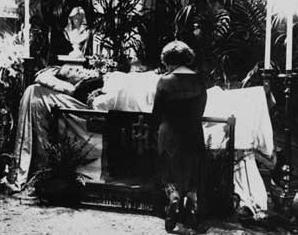
|
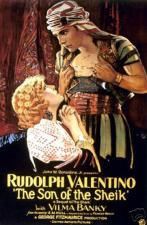
|
Le vin et le lait - Wine and Milk
Wine is felt by the French nation to be a possession which is its
very own, just like its three hundred and sixty types of cheese and
its culture. It is a totem-drink, corresponding to the milk of the
Dutch cow or the tea ceremonially taken by the British Royal Family.
...
...
Le plastique - Plastic
Despite having names of Greek shepherds (Polystyrene, Polyvinyl,
Polyethylene), plastic, the products of which have just
been gathered in an exhibition, is in essence the stuff of alchemy. At
the entrance of the stand, the public waits in a long queue in
order to witness the accomplishment of the magical operation
par excellence: the transmutation of matter. An ideally-
shaped machine, tubulated and oblong (a shape well suited to suggest the
secret of an itinerary) effortlessly draws, out of a heap of greenish
crystals, shiny and fluted dressing -room tidies. At one end, raw,
telluric matter, at the other, the finished, human object; and
between these two extremes, nothing; nothing but a transit, hardly watched
over by an attendant in a cloth cap, half-god, half-robot. So, more than
a substance, plastic is the very idea of its infinite
transformation; as its everyday name indicates, it is ubiquity made
visible. And it is this, in fact, which makes it a miraculous
substance: a miracle is always a sudden transformation of nature.
Plastic remains impregnated throughout with this wonder: it is less
a thing than the trace of a movement.
And as the movement here is almost infinite, transforming the
original crystals into a multitude of more and more startling
objects, plastic is, all told, a spectacle to be deciphered: the
very
spectacle of its end-products. At the sight of each terminal form
(suitcase, brush, car-body, toy, fabric, tube, basin or paper),
the
mind does not cease from consider
ing the original matter as an
enigma. This is because the quick-change artistry of plastic is
absolute: it can become buckets as well as jewels. Hence a
perpetual amazement, the reverie of man at the sight of the
proliferating forms of matter, and the connections he detects
between the singular of the origin and the plural of the effects. And
this amazement is a pleasurable one, since the scope of the
transformations gives man the measure of his power, and since the
very itinerary of plastic gives him the euphoria of a prestigious
free-wheeling through Nature.
But the price to be paid for this success is that plastic, sublimated as
movement, hardly exists as substance. Its reality is a negative
one: neither hard nor deep, it must be content with a
'substantial' attribute which is neutral in spite of its
utilitarian advantages: resistance , a state which merely means an
absence of yielding. In the hierarchy of the major poetic
substances, it figures as a disgraced material, lost between the
effusiveness of rubber and the flat hardness of metal; it embodies none of
the genuine produce of the mineral world: foam, fibres, strata. It
is a 'shaped' substance: whatever its final state, plastic keeps
a flocculent appearance, something opaque, creamy and curdled, something
powerless ever to achieve the triumphant smoothness of Nature. But
what best reveals it for what it is is the sound it gives, at
once hollow and flat; its noise is its undoing, as are its colours, for
it seems capable of retaining only the most chemicallooking ones. Of
yellow, red and green, it keeps only the aggressive quality, and
uses them as mere names, being able to display only concepts of colours.
The fashion for plastic highlights an evolution in the myth of
'imitation' materials. It is well known that their use is
historically bourgeois in origin (the first vest imentary postiches
date back to the rise of capitalism). But until now imitation
materials have always indicated pretension, they belonged to
the world of appearances, not to that of actual use; they
aimed at reproducing cheaply the rarest substances, diamonds, silk,
feathers, furs, silver, all the luxurious brilliance of the world. Plastic
has climbed down, it is a household material. It is the first
magical substance which consents to be prosaic. But it is
precisely because this prosaic character is a triumphant reason for its
existence: for the first time, artifice aims at something common, not rare.
And as an immediate ronsequence, the age-old function of nature is
modified: it is no longer the Idea, the pure Substance to be
regained or imitated: an artificial Matter, more bountiful th an
all the natural deposits, is about to replace her, and to determine
the very invention of forms. A luxurious object is still of this
earth, it still recalls, albeit in a
precious mode, its mineral or animal origin, the natural
theme of which it is but one actualization. Plastic is wholly swallowed
up in the fact of being used: ultimately, objects will be invented
for the sole pleasure of using them. The hierarchy of
substances is abolished: a single one replaces them all: the
whole world can be plasticized, and even life itself since,
we are told, they are beginning to make plastic aortas.
Myth Today
Pages 181 to 233 in the original French edition. Pages 108? to 162? in the
1972 printed English edition. Pages 106 to 160 of the electronic edition
paginated below.
Page: 107 -
108 -
109 -
110 -
111 -
115 -
116 -
118 -
122 -
124 -
125 -
126 -
127 -
129 -
130 -
131 -
137 -
138 -
140 -
MYTH TODAY:
Myth is a type of speech
-
Myth as a
semiological system
-
The form and the concept -
The signification -
Reading and deciphering myth
-
Myth as
stolen language -
The bourgeoisie as a joint-stock company - Myth is depoliticized
speech -
Myth on the Left - Myth on the Right - Necessity and limits of mythology
Myth is a type of speech
What is a
myth, today? I shall give at the outset a first, very simple
answer, which is perfectly consistent with
etymology: myth is a type of
speech.
Qu'est-ce qu'un mythe aujourd'hui ? Je donnerai tout de
suite une première réponse très simple, qui s'accorde
parfaitement avec l'étymologie : le mythe est une parole. [Parole
can
mean a word or speech]
... it is not any type:
language
needs special conditions in order to
become myth ... But what must be firmly established at the start is that
myth is a system of communication, that it is a message. This allows one to
perceive that myth cannot possibly be an object, a concept, or an idea; it
is a mode of
signification, a
form. Later, we
shall have
to assign to this
form historical limits, conditions of use, and reintroduce society into it:
we must nevertheless first describe it as a form.
... since myth is a type of speech, everything can be a myth provided
it is conveyed by a
discourse. Myth is not defined by the object of
its message, but by the way in which it utters this message: there
are formal limits to myth, there are no 'substantial' ones.
Everything... can be a myth. ... every object in the
world can pass from a closed, silent existence to an oral state, open
to appropriation by society, for there is no law, whether natural or
not, which forbids talking about things. A tree is a tree. Yes, of
course. But a
tree as expressed by Minou Drouet [A controversial eight year
old poet] is no longer quite
a tree, it is a tree which is decorated, adapted to a certain type of
[p.108] consumption, laden with literary self-indulgence, revolt, images,
in short with a type of social usage which is added to pure matter.
this is well known and has been said a thousand times in folklore,
proverbs, conversations and Literature. But this very universality implies
a kind of conformism: to believe in wine is a coercive collective act. A
Frenchman who kept this myth at arm's length would expose himself to minor
but definite problems of integration, the first of which, precisely, would
be that of having to explain his attitude. The universality principle fully
applies here, inasmuch as society calls anyone who does not believe in wine
by names such as sick, disabled or depraved: it does not comprehend him (in
both senses, intellectual and spatial, of the word). Conversely, an award
of good integration is given to whoever is a practising wine-drinker:
knowing how to drink is a national technique which serves to qualify the
Frenchman, to demonstrate at once his performance, his control and his
sociability.
The mythology of wine can in fact help us to understand the usual
ambiguity of our daily life. For it is true that wine is a good and
fine substance, but it is no less true that its production is deeply
involved in French capitalism, whether it is that of the private
distillers or that of the big settlers in Algeria who impose on the
Muslims, on the very land of which they have been dispossessed, a
crop of which they have no need, while they lack even bread.
There are thus very engaging myths which are however not
innocent. And the characteristic of our current alienation is
precisely that wine cannot be an unalloyedly blissful substance,
except if we wrongfully forget that it is also the product of an
expropriation.
p.107
|
"Tree that I Love"
by Minou Drouet
Tree that I love,
|
Pictures become a kind of
writing
as soon as they are
meaningful: like writing, they call for a lexis. [a way of being written?
or an interpretation?]
We shall therefore take language, discourse, speech , etc., to mean any
significant unit or synthesis, whether verbal or visual: a photograph will
be a kind of speech for us in the same way as a newspaper article; even
objects will become speech, if they mean something. This generic way of
conceiving language is in fact justified by the very
history of
writing: long before the invention of
our alphabet,
objects like the Inca
quipu , or
drawings, as in pictographs, have been accepted as speech...
Myth as a semiological system
... mythology, since it is the study of a type of speech, is but one
fragment of this vast science of signs which
Saussure. postulated
... under the name of semiology...
since Saussure ... a whole section of contemporary research has constantly
been referred to the problem of meaning: psycho-analysis, structuralism,
eidetic psychology, some new types of literary criticism of which
Bachelard
has given the first examples, are no longer concerned with facts except
inasmuch as they are endowed with significance.
Now to postulate a signification is to have recourse to semiology. I do not
mean that semiology could account for all these aspects of research equally
well: they have different contents. But they have a common status: they are
all sciences dealing with values. They are not content with meeting the
facts: they define and explore them as tokens for something else.
Semiology is a science of
forms, since it
studies significations
apart from their content...
La sémiologie est une science des formes ; elle étudie des
significations indépendamment de leur contenu.
Less terrorized by the spectre of 'formalism', historical criticism might
have been less sterile; it would have
[p.111] understood that the specific
study of
forms does not in any way contradict the necessary principles of totality
and History.
The important thing is to see that the unity of an explanation cannot be
based on the amputation of one or other of its approaches, but, as Engels
said, on the dialectical co-ordination of the particular sciences it makes
use of. This is the case with mythology: it is a part both of semiology
inasmuch as it is a formal science, and of ideology inasmuch as it is an
historical science: it studies ideas-in-form.
Let me therefore restate that any
semiology postulates a relation
between two terms, a
signifier and a
signified. This relation
concerns objects which belong to different categories, and this is
why it is not one of equality but one of equivalence.
We must here be on our guard for despite common parlance which simply says
that the signifier expresses the signified, we are dealing, in any
semiological system, not with two, but with three different terms. For what
we grasp is not at all one term after the other, but the correlation which
unites them: there are, therefore, the signifier, the signified and the
sign, which is the associative total of the first two terms.
Take a bunch of roses: I use it to
signify
my passion. Do
we have here, then, only a signifier and a signified, the roses and
my passion? Not even that: to put
it accurately, there are here only
'passionified' roses. But on the plane of analysis, we do have three
terms; for these roses weighted with passion perfectly and
correctly allow themselves to
be decomposed into roses and
passion: the former and the latter existed before uniting and forming this
third object, which is the
sign. It is as true to say that
on the plane of experience I cannot dissociate the roses from the
message they carry, as to say that on the plane of analysis I cannot
confuse the roses as signifier and the roses as sign: the signifier is
empty, the sign is full, it is a
meaning.
Or take a black pebble: I can make it signify in several ways, it is a mere
signifier; but if I weigh it with a definite signified (a death sentence,
for instance, in an anonymous vote), it will become a sign.
p.109
p.110
...
In myth, we find again the tri-dimensional pattern which I have
just described: the signifier, the signified and the sign. But myth is
a peculiar system, in that it is constructed from a semiological
chain which existed before it: it is a second-order semiological
system. That which is a sign (namely the associative total of a
concept and an image) in the first system, becomes a mere signifier
in the second.
...
We must here recall that the materials of mythical speech (the language
itself, photography, painting, posters, rituals, objects, etc.), however
different at the start, are reduced to a pure signifying function as soon
as they are caught by myth. Myth sees in them only the same raw material;
their unity is that they all come down to the status of a mere language.
Whether it deals with alphabetical or pictorial writing, myth wants to see
in them only a sum of signs, a global sign, the final term of a first
semiological chain. And it is precisely this final term which will become
the first term of the greater system which it builds and of which it is
only a part.
...

|
...
here is now [an]... example: I am at the barber's, and a copy of Paris- Match is offered to me. On the cover, a young Negro in a French uniform is saluting, with his eyes uplifted, probably fixed on a fold of the tricolour. All this is the meaning of the picture.
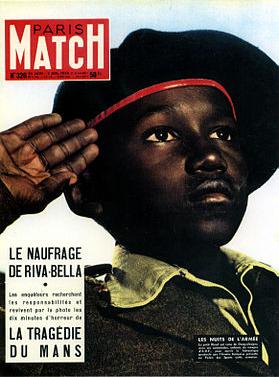
|
But, whether naively or not, I see very well what it signifies to me: that France is a great Empire, that all her sons, without any colour discrimination, faithfully serve under her flag, and that there is no better answer to the detractors of an alleged colonialism than the zeal shown by this Negro in serving his so-called oppressors. I am therefore again faced with a greater semiological system: there is a signifier, itself already formed with a previous system (a black soldier is giving the French salute); there is a signified (it is here a purposeful mixture of Frenchness and militariness); finally, there is a presence of the signified through the signifier. |
Before tackling the analysis of each term of the mythical system, one must agree on terminology. We now know that the signifier can be looked at, in myth, from two points of view: as the final term of the linguistic system, or as the first term of the mythical system. We therefore need two names. On the plane of language, that is, as the final term of the first system, I shall call the signifier: meaning (... a Negro is giving the French salute); on the plane of myth, I shall call it: form.
In the case of the signified, no ambiguity is possible: we shall retain the name concept . The third term is the correlation of the first two: in the linguistic system, it is the sign ; but it is not possible to use this word again without ambiguity, since in myth (and this is the chief peculiarity of the latter), the signifier is already formed by the signs of the language. I shall call the third term of myth the signification.
This word is here all the better justified since myth has in fact a double function: it points out and it notifies, it makes us understand something and it imposes it on us.
The form and the concept
In this sense, we can say that the fundamental character of the
mythical concept is to be appropriated: ... French imperiality
must appeal to such and such group of readers and not another.
The concept closely corresponds to a function, it is defined as a
tendency.
This cannot fail to recall the signified in another semiological system,
Freudianism. In Freud, the second term of the system is the
latent meaning
(the content) of the dream, of the parapraxis, of the neurosis. Now Freud
does remark that the second-order meaning of behaviour is its real meaning,
that which is appropriate to a complete situation, including its deeper
level; it is, just like the mythical concept, the very intention of
behaviour.
The signification
myth is a type of speech defined by its intention ...
much more than by its literal sense... in
spite of this, its intention is somehow frozen, purified, eternalized,
[p.133] made
absent by this literal sense (The
French
Empire? It's just a fact: look at
this
good Negro who salutes like one of our own boys).
this
interpellant speech is at the same time a frozen speech: at the
moment
of reaching me, it suspends itself, turns away and assumes the look of a
generality: it stiffens, it makes itself look neutral and innocent. The
appropriation of the concept is suddenly driven away once more by the
literalness of the meaning. This is a kind of arrest , in both the physical
and the legal sense of the term: French imperiality condemns the
saluting
Negro to be nothing more than an instrumental signifier, the
Negro suddenly
hails me in the name of French imperial ity; but at the same moment the
Negro's salute thickens, becomes vitrified, freezes into an eternal
reference meant to establish French imperiality. On the surface of language
something has stopped moving: the use of the signification is here, hiding
behind the fact, and conferring on it a notifying look; but at the same
time, the fact paralyses the intention, gives it something like a malaise
producing immobility: in order to make it innocent, it freezes it. This is
because myth is speech stolen and restored . Only, speech which is restored
is no longer quite that which was stolen: when it was brought back, it was
not put exactly in its place. It is this brief act of larceny, this moment
taken for a surreptitious faking, which gives mythical speech its benumbed
look.
One last element of the signification remains to be examined: its
motivation. We know that in a language, the sign is arbitrary: nothing
compels the acoustic image tree 'naturally' to mean the concept tree: the
sign, here, is unmotivated. Yet this arbitrariness has limits, which come
from the associative relations of the word: the language can produce a
whole fragment of the sign by analogy with other signs (for instance one
says aimable in French, and not amable, by analogy with aime). The
mythical signification, on the other hand, is never arbitrary; it is always
in part motivated, and unavoidably contains some analogy. ... for French
imperiality to get hold of the
saluting Negro, there must be identity
between the Negro's
[p.125] salute and that of the French soldier.
Motivation is
necessary to the very duplicity of myth: myth plays on the analogy between
meaning and
form, there is no
myth without motivated form.
p.115/116
...
knowledge contained in a mythical concept is confused, made of yielding,
shapeless associations. One must firmly stress this open character of the
concept; it is not at all an abstract, purified essence; it is a formless,
unstable, nebulous condensation, whose unity and coherence are above all
due to its function.
p.118
...
p.122
...
Myth has an imperative, buttonholing character: stemming from an
historical concept, directly springing from contingency (... a
threatened
Empire), it is I whom it has come to seek. It is turned towards
me, I am
subjected to its intentional force, it
summons me to receive its expansive ambiguity.
...
p.124
...
Motivation is unavoidable. It is none the less very fragmentary. To
start with, it is not 'natural': it is history which supplies its
analogies to the form. Then, the analogy between the meaning and
the concept is never anything but partial: the form drops many
analogous features and keeps only a few...
...
a complete image would exclude myth, or at least would compel it to
seize only its very completeness.
...
in general myth prefers to work with poor, incomplete images, where the
meaning is already relieved of its fat, and ready for a signification, such
as caricatures, pastiches, symbols, etc.
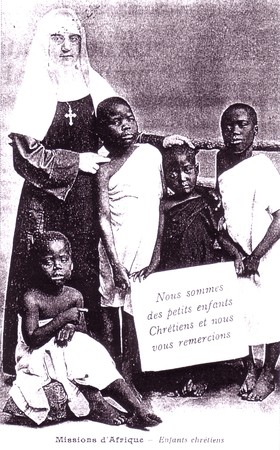
French Charity Postcard 1910-1920 |
Finally, the motivation is chosen
among other possible ones: I can very well give to French imperiality many
other signifiers beside
a Negro's salute: a French general pins a
decoration on a one-armed Senegalese, a nun hands a cup of tea to a bed-
ridden Arab, a white schoolmaster teaches attentive
[p.126] piccaninnies:
the press
undertakes every day to demonstrate that the store of mythical signifiers
is inexhaustible.
Enfin la motivation est choisie parmi d'autres possibles : je puis
donner à l'impérialité française bien d'autres
signifiants que le salut militaire d'un nègre : un
général français décore
un Sénégalais manchot, une bonne soeur tend de la tisane
à un bicot alité, un instituteur blanc fait la classe
à de jeunes négrillons attentifs : la presse se charge de
démontrer tous les jours que la réserve des signifiants
mythiques
est inépuisable.
|
The nature of the mythical signification can in fact be well conveyed by one particular simile: it is neither more nor less arbitrary than an ideograph. Myth is a pure ideographic system, where the forms are still motivated by the concept which they represent while not yet, by a long way, covering the sum of its possibilities for representation. And just as, historically, ideographs have gradually left the concept and have become associated with the sound, thus growing less and less motivated, the worn out state of a myth can be recognized by the arbitrariness of its signification: the whole of Molière is seen in a doctor's ruff.
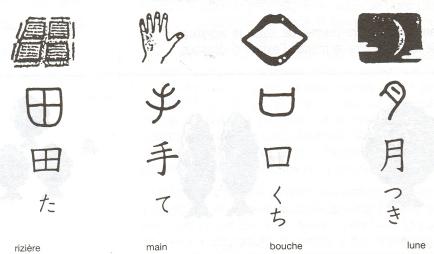
|
Historically the ideograph (picture writing symbol) moves from association with the concept (paddy field, hand, mouth, moon) to association with the sound used to express them (in French: riziêre, main, bouche, lune) |
Reading and deciphering myth
How is a myth received? We must here once more come back to the duplicity
of its signifier, which is at once meaning and form. I can produce three
different types of reading by focusing on the one, or the other, or both at
the same time.
1. If I focus on an empty signifier, I let the concept fill the form of
the myth without ambiguity, and I find myself before a simple
system, where the signification becomes literal again: the
Negro
who salutes is an example of French imperiality, he is a
symbol for it. This type of focusing is, for instance, that of the producer
of myths, of the journalist who starts with a concept and seeks a form
for it.
2. If I focus on a full signifier, in which I clearly distinguish the
meaning and the form, and consequently the distortion which the
one imposes on the other, I undo the signification of the myth, and
I receive the latter as an imposture: the saluting Negro becomes the
alibi of French imperiality. This type of focusing is that of the
mythologist: he deciphers the myth, he understands a distortion.
3. Finally, if I focus on the mythical signifier as on an inextricable
whole made of meaning and form, I receive an ambiguous signification: I
respond to the constituting mechanism of myth, to its own dynamics, I
become a reader of myths. The
saluting Negro is no longer an example or a symbol, still less
an alibi: he is the very presence of French imperiality.
The first two types of focusing are static, analytical; they destroy
the myth, either by making its intention obvious, or by unmasking
it: the former is cynical, the latter demystifying. The third type of
focusing is dynamic, it consumes the myth according to the very
ends built into its structure: the reader lives the myth as a story at
once true and unreal.
If one wishes to connect a mythical schema to a general history, to
explain how it corresponds to the interests of a definite society, in
short, to pass from
semiology to
ideology, it is obviously at the
level of the third type of focusing that one must place oneself: it is
the reader of myths himself who must reveal their essential
function. How does he receive this particular myth
today
If he
receives it in an innocent fashion, what is the point of proposing it
to him? And if he reads it using his powers of reflection, like the
mythologist, does it matter which alibi is presented? If the reader
does not see French imperiality in the saluting Negro, it was not
worth weighing the latter with it; and if he sees it, the myth is
nothing more than a political proposition, honestly expressed. In
one word, either the intention of the myth is too obscure to be
efficacious, or it is too clear to be believed, In either case, where is
the ambiguity?
This is but a false dilemma. Myth hides nothing and flaunts
nothing: it distorts; myth is neither a lie nor a confession: it is an
inflexion. Placed before the dilemma which I mentioned a moment
ago, myth finds a third way out. Threatened with disappearance if
it yields to either of the first two types of focusing, it gets out of
this tight spot thanks to a compromise-it is this compromise.
Entrusted with 'glossing over' an intentional concept, myth
encounters nothing but betrayal in language, for language can only
obliterate the concept if it hides it, or unmask it if it formulates it.
The elaboration of a second-order semiological system will enable
myth to escape this dilemma: driven to having either to unveil or to
liquidate the concept, it will naturalize it.
We reach here the very principle of myth: it transforms
history into
nature. We now understand why, in the eyes of the myth-consumer,
the intention, the adhomination [making personal?] of the concept can
remain manifest without however appearing to have an interest in the
matter: what causes mythical speech to be uttered is perfectly explicit,
but it is immediately frozen into something natural; it is not read as a
motive, but as a reason. If I read the Negro-saluting as symbol pure
and simple of imperiality, I must renounce the reality of the picture, it
discredits itself in my eyes when it becomes an
[p. 129] instrument.
Conversely, if I decipher the Negro's salute as an alibi of coloniality, I
shatter the myth even more surely by the obviousness of its motivation. But
for the myth-reader, the outcome is quite different: everything happens as
if the picture naturally conjured up the concept, as if the signifier
gave a foundation to the signified: the myth exists from the precise
moment when French imperiality achieves the natural state: myth
is speech justified in excess.
Here is a new example which will help understand clearly how the
myth-reader is led to rationalize the signified by means of the
signifier. We are in the
month of July, I read a big headline in
France-Soir:
Let us quickly sketch
the semiological schema: the example being a sentence, the first
system is purely linguistic. The signifier of the second system is
composed here of a certain number of accidents, some lexical (the
words: first, begins, the [fall]), some typographical (enormous
headlines where the reader usually sees news of world importance). The
signified or concept is what must be called by a barbarous but unavoidable
neologism: governmentality, the Government presented by the national press
as the Essence of efficacy. The signification of the myth follows clearly
from this: fruit and vegetable prices are falling because the government
has so decided. Now it so happens in this case (and this is on the whole
fairly rare) that the newspaper itself has, two lines below, allowed
one to see through the myth which it had just elaborated whether this is
due to self-assurance or honesty. It adds (in small type, it is
true): 'The fall in prices is helped by the return of seasonal abundance.'
This example is instructive for two reasons. Firstly it conspicuously shows
that myth essentially aims at causing an immediate impression - it does not
matter if one is later allowed to see through the myth, its action is
assumed to be stronger than the rational explanations which may later belie
it. This means that the reading of a myth is exhausted at one stroke. I
cast a quick glance at my neighbour's France-Soir: I cull only a meaning
there, but I read a true signification; I receive the presence of
governmental action in the fall in fruit and vegetable prices. That is all,
and that
[130] is enough. A more attentive reading of the myth will in no
way increase its power or its ineffectiveness: a myth is at the same time
imperfectible and unquestionable; time or knowledge will not make it better
or worse.
Secondly, the naturalization of the concept, which I have just
identified as the essential function of myth, is here exemplary. In a
first (exclusively linguistic) system, causality would be, literally,
natural: fruit and vegetable prices fall because they are in season.
In the second (mythical) system, causality is artificial, false; but it
creeps, so to speak, through the back door of Nature. This is why
myth is experienced as innocent speech: not because its intentions
are hidden - if they were hidden, they could not be efficacious - but
because they are naturalized.
In fact, what allows the reader to consume myth innocently is that
he does not see it as a semiological system but as an inductive one.
Where there is only an equivalence, he sees a kind of causal
process: the signifier and the signified have, in his eyes, a natural
relationship. This confusion can be expressed otherwise: any
semiological system is a system of values; now the myth-consumer
takes the signification for a system of facts: myth is read as a
factual system, whereas it is but a semiological system.
Myth as stolen language
What is characteristic of myth? To transform a meaning into form.
In other words, myth is always a language-robbery. I rob the Negro
who is saluting ... not to make [him] into ..[a symbol].. but to
naturalize through [him] the
Empire...
The
bourgeoisie as a joint-stock company
Myth lends itself to history in two ways: by its form, which is only
relatively motivated; by its concept, the nature of which is
historical. One can therefore imagine a diachronic study of myths, whether
one submits them to a retrospection (which means founding an historical
mythology) or whether one follows some of yesterday's myths down to their
present forms (which means founding prospective history). If I keep here to
a synchronic sketch of contemporary myths, it is for an objective reason:
our society is the privileged field of mythical significations. We must now
say why.
Whatever the accidents, the compromises, the concessions and the
political adventures, whatever the technical, economic, or even
social changes which history brings us, our society is still a
bourgeois society. I am not forgetting that since
1789, in France,
several types of bourgeoisie have succeeded one another in power;
but the same status - a certain regime of ownership, a certain order,
a certain ideology - remains at a deeper level. Now a remarkable
phenomenon occurs in the matter of naming this regime: as an
economic fact, the bourgeoisie is named without any difficulty:
capitalism is openly professed.
As a political fact, the bourgeoisie has some difficulty in acknowledging
itself: there are no 'bourgeois' parties in the Chamber. As an ideological
fact, it completely disappears: the bourgeoisie has obliterated its name in
passing from reality to representation, from economic man to mental man.
...
Politically, the haemorrhage of the name
'bourgeois' is effected through the idea of
nation. This was once a progressive idea, which has served to get rid of
the aristocracy; today, the bourgeoisie merges into the nation, even if it
has, in order to do so, to exclude from it the elements which it decides
are allogenous (the Communists).
...
It is therefore by penetrating the intermediate classes that the
bourgeois ideology can most surely lose its name. Petit-bourgeois
norms are the residue of bourgeois culture, they are bourgeois
truths which have become degraded, impoverished, commercialized, slightly
archaic, or shall we say, out of date? The political alliance of the
bourgeoisie and the petite-bourgeoisie has for more than a century
determined the history of France; it has rarely been broken, and each time
only temporarily
(1848,
1871,
1936). This
alliance got closer as time passed, it gradually became
a symbiosis; transient awakenings might happen, but the common
ideology was never questioned again. The same 'natural' varnish
covers up all 'national' representations: the big wedding of the
bourgeoisie, which originates in a class ritual (the display and
consumption of wealth), can bear no relation to the economic
status of the lower middle-class: but through the press, the news,
and literature, it slowly becomes the very norm as dreamed, though
not actually lived, of the petit-bourgeois couple. The bourgeoisie is
constantly absorbing into its ideology a whole section of humanity
which does not have its basic status and cannot live up to it except
in imagination, that is, at the cost of an immobilisation and an
impoverishment of consciousness.
p.127
[symbol of: it just represents in order to communicate?
[alibi: something designed to prove the innocence of?
THE FALL IN PRICES: FIRST INDICATIONS.
VEGETABLES: PRICE DROP BEGINS.
...
p.131
p.137
Note 14: "The fate of capitalism is to make the worker wealthy,"
Paris-Match tells us.
p.138
...
in a bourgeois culture, there is neither proletarian culture nor
proletarian morality, there is no proletarian art; ideologically, all that
is not bourgeois is obliged to borrow from the bourgeoisie. Bourgeois
ideology can therefore spread over everything and in so doing lose its name
without risk: no one here will throw this name of bourgeois back at it.
This anonymity of the bourgeoisie becomes even more marked when one passes
from bourgeois culture proper to its derived,
vulgarized and applied forms, to what one could call public
philosophy, that which sustains everyday life, civil ceremonials,
secular rites, in short the unwritten norms of interrelationships in a
bourgeois society. It is an illusion to reduce the dominant culture to
its inventive core: there also is a bourgeois culture which consists
of consumption alone. The whole of France is steeped in this
anonymous ideology: our press, our films, our theatre, our pulp
literature, our rituals, our justice, our diplomacy, our
conversations, our remarks about the weather, a murder trial, a
touching wedding, the cooking we dream of, the garments we
wear, everything, in everyday life, is dependent on the
representation which the bourgeoisie has and makes us have
of the relations between man and the world. These 'normalized' forms
attract little attention, by the very fact of their extension, in which
their origin is easily lost. They enjoy an intermediate position:
being neither directly political nor directly ideological, they live
peacefully between the action of the militants and the quarrels of
the intellectuals; more or less abandoned by the former and the
latter, they gravitate towards the enormous mass of the
undifferentiated, of the insignificant, in short, of nature. Yet it is
through its ethic that the bourgeoisie pervades France: practised on
a national scale, bourgeois norms are experienced as the evident
laws of a natural order - the further the bourgeois class propagates
its representations, the more naturalized they become. The fact
[p.140]
of the bourgeoisie becomes absorbed into an amorphous universe,
whose sole inhabitant is Eternal Man, who is neither proletarian
nor bourgeois.
Footnote 19: To induce a collective content for the imagination is always
an inhuman undertaking, not only because dreaming essentializes life
into destiny, but also because dreams are impoverished, and the
alibi of an absence

|
By spreading its representations over a whole catalogue of collective images for petit-bourgeois use, the bourgeoisie countenances the illusory lack of differentiation of the social classes: it is as from the moment when a typist earning twenty pounds a month recognizes herself in the big wedding of the bourgeoisie that bourgeois ex-nomination achieves its full effect. |
The flight from the name 'bourgeois' is not therefore an illusory, accidental, secondary, natural or insignificant phenomenon: it is the bourgeois ideology itself, the process through which the bourgeoisie transforms the reality of the world into an image of the world, History into Nature.
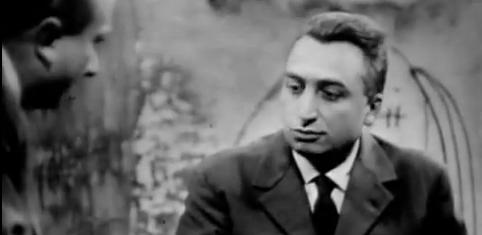
|
Roland Barthes appeared on French Television discussing Mythologies in "Lectures pour tous" on 29.5.1957 You Tube |
"Lectures pour tous" (on French television) described by Vincent Casanova
A television show created in 1953 by Pierre Desgraupes and Pierre Dumayet, seeking to give the public a taste of the books it discused. Television was then considered an invitation to culture...
The small screen's mission was to educate as well as entertain. Often led by men from the resistance who sought to make art an instrument of emancipation, television gave the floor to the great writers and intellectuals of the time.
Pierre Desgraupes presents Mythologies in a way that makes the work accessible and clarifies the intentions of the author. He opens with a very general question: "How could you define your job?" and what follows appears therefore as the explicitation of the concise answer of Barthes.
In the manner of a Professor (the camera angle accentuates the address to the Viewer), Desgraupes outlines the first part of the Mythologies putting aside part two as more theoretical and likely to be more difficult to understand. He also chooses a very evocative example (wrestling) to present to the public.
The beginning of what they said:
Pierre Desgraupes
How could we describe your work?
Roland Barthes
I am a little embarrassed because as it finally presents itself it is only a collection of articles analysing myths of modern daily life for us in France. All of that crowned by a more theoretical text on what can be a little more abstractly, the notion of myth today.
Pierre Desgraupes
OK. So let us take the first part, this catalogue of materials on which you have done analyses. They are obviously very different from a simple inventory, but just the subjects are striking.
I think the viewers, the future readers of your book, will be struck by the fact that the chapter headings, the subjects of your analysis, are topics which are generally very familiar.
Here is one on a soap product that the viewers are reminded about every day in advertisements, here is one on the professional wrestling they [now] see on television, and one on the Abbé Pierre who they so often read about in the newspapers.
I think you could say that, there is initially a census of some of the major myths that weave our everyday life, is that not so?
Roland Barthes
But yes, indeed, that is exactly how I saw them. They were part of my reality as they were part of the reality of every other French person at the time.
Pierre Desgraupes
But at this point, clearly, things get more complicated, for it is the moment where you have to explain what work you have done on these materials. How you are trying to elucidate them, in what sense?
Roland Barthes
In a nutshell, I try to see what they contain of large collective representations, recalling within themselves something mythical of the past, but despite that, being of our time. These collective representations are produced by our society and our history.
Pierre Desgraupes
That is well said. I think, if you agree, we could take some of the chapters of your book as illustrations of it. There are many and I have chosen only a few.
What would you say characterises wrestling, or perhaps even explains, in a sense, the success of wrestling for the public?
Roland Barthes
Yes, at one time, I went very often to professional wrestling, especially
in a small... popular enough room that is the Elysee Montmartre.
...
And I have always been very struck by the fact that this show called a
"sport", is not.
In reality, it overlaps, for example, with the commedia dell'arte. It is a piece of theatre (scenario) in which the wrestlers improvise episodes.
All these episodes and this scenario have, in my view, an essentially moral sense. They mimic, through their improvisations, the ancestral imagery of any kind of combat, with the figures of justice, of triumph and of defeat, the image of the ordeal and, fundamentally, the payment.
The justice of wrestling is a justice of the payment. One hears very often the public yelling: "Make him pay!. They are calling for the bastard to be made to pay.
Pierre Desgraupes
Yes, that is, you write in your book that wrestling is made to express a certain idea of justice somehow.
Roland Barthes
Exactly.
commedia dell'arte: Comedy of art or of the profession.
An unwritten or improvised drama that flourished in Italy in the sixteenth
and seventeenth centuries.
images ancestrales: ancient and universal images that constitute a
permanent legacy in the history of humanity (for example, myths, symbols).
Jung (1919) called these archetypes.
In his Course in General Linguistics, first published in 1916, Saussure
postulated the existence of a general science of signs, or Semiology, of
which linguistics would form only one part. Semiology therefore aims to
take in any system of signs, whatever their substance and limits; images,
gestures, musical sounds, objects, and the complex associations of all
these, which form the content of ritual, convention or public
entertainment: these constitute, if not languages, at least systems of
signification. There is no doubt that the development of mass
communications confers particular relevance today upon the vast field of
signifying media, just when the success of disciplines such as linguistics,
information theory, formal logic and structural anthropology provide
semantic analysis with new instruments. There is at present a kind of
demand for semiology, stemming not from the fads of a few scholars, but
from the very history of the modern world.
The fact remains that, although Saussure's ideas have made great headway,
semiology remains a tentative science. The reason for this may well be
simple. Saussure, followed in this by the main semiologists, thought that
linguistics merely formed a part of the general science of signs. Now it is
far from certain that in the social life of today there are to be found any
extensive systems of signs outside human language. Semiology has so far
concerned itself with codes of no more than slight interest, such as the
Highway Code; the moment we go on to systems where the sociological
significance is more than superficial, we are once more confronted with
language. it is true that objects, images and patterns of behaviour can
signify, and do so on a large scale, but never autonomously; every
semiological system has its linguistic admixture. Where there is a visual
substance, for example, the meaning is confirmed by being duplicated in a
linguistic message (which happens in the case of the cinema, advertising,
comic strips, press photography, etc.) so that at least a part of the
iconic message is, in terms of structural relationship, either redundant or
taken up by the linguistic system. As for collections of objects (clothes,
food), they enjoy the status of systems only in so far as they pass through
the relay of language, which extracts their signifiers (in the form of
nomenclature) and names their signifieds (in the forms of usages or
reasons): we are, much more than in former times, and despite the spread of
pictorial illustration, a civilisation of the written word. Finally, and in
more general terms, it appears increasingly more difficult to conceive a
system of images and objects whose signifieds can exist independently of
language: to perceive what a substance signifies is inevitably to fall back
on the individuation of a language: there is no meaning which is not
designated, and the world of signifieds is none other than that of
language.
Thus, though working at the outset on nonlinguistic substances, semiology
is required, sooner or later, to find language (in the ordinary sense of
the term) in its path, not only as a model, but also as component, relay or
signified. Even so, such language is not quite that of the linguist: it is
a second-order language, with its unities no longer monemes or phonemes,
but larger fragments of discourse referring to objects or episodes whose
meaning underlies language, but can never exist independently of it.
Semiology is therefore perhaps destined to be absorbed into a trans-
linguistics, the materials of which may be
myth,
narrative, journalism, or
on the other hand objects of our
civilisation, in so far as they are spoken
(through press, prospectus, interview, conversation and perhaps even the
inner language, which is ruled by the laws of
imagination). In fact, we
must now face the possibility of inverting Saussure's declaration:
linguistics is not a part of the general science of signs, even a
privileged part, it is semiology which is a part of linguistics: to be
precise, it is that part covering the great signifying unities of
discourse. By this inversion we may expect to bring to light the unity of
the research at present being done in anthropology, sociology,
psychoanalysis and stylistics round the concept of signification.
Though it will doubtless be required some day to change its character,
semiology must first of all, if not exactly take definite shape, at least
try itself out, explore its possibilities and impossibilities. This is
feasible only on the basis of preparatory investigation. And indeed it must
be acknowledged in advance that such an investigation is both diffident and
rash: diffident because semiological knowledge at present can be only a
copy of linguistic knowledge; rash because this knowledge must be applied
forthwith, at least as a project, to non-linguistic objects.
The Elements here presented have as their sole aim the extraction from
linguistics of analytical concepts, which we think a priori to be
sufficiently general to start semiological research on its way. In
assembling them, it is not presupposed that they will remain intact during
the course of research; nor that semiology will always be forced to follow
the linguistic model closely.' We are merely suggesting and elucidating a
terminology in the hope that it may enable an initial (albeit provisional)
order to be introduced into the heterogeneous mass of significant facts. In
fact what we purport to do is to furnish a principle of classification of
the questions.
These elements of semiology will therefore be grouped under four main
headings borrowed from structural linguistics:
It will be seen that these headings appear in dichotomic form; the reader
will also notice that the binary classification of concepts seems frequent
in structural thoughts as if the
metalanguage of the linguist reproduced, like a mirror, the
binary structure of the system it is describing; and we shall point out, as
the occasion arises, that it would probably be very instructive to study
the pre-eminence of binary classification in the discourse of contemporary
social sciences. The taxonomy of these sciences, if it were well known,
would undoubtedly provide a great deal of information on what might be
called the field of intellectual imagination in our time.
...
1.2.6. Problems (I) - the origin of the various signifyings systems:
The semiological extension of the language/speech notion brings with it
some problems, which of course coincide with the points where the
linguistic model can no longer be followed and must be altered. The first
problem concerns the origin of the various systems, and thus touches on the
very dialectics of language and speech. In the linguistic model, nothing
enters the language without having been tried in speech, but conversely no
speech is possible (that is, fulfils its function of communication) if it
is not drawn from the 'treasure' of the language. This process is still, at
least partially, found in a system like that of food, although individual
innovations brought into it can become language phenomena. But in most
other semiological systems, the language is elaborated not by the 'speaking
mass' but by a deciding group. In this sense, it can be held that in most
semiological languages, the sign is really and truly 'arbitrary"' since it
is founded in artificial fashion by a unilateral decision; these in fact
are fabricated languages, 'logo-techniques'. The user follows these
languages, draws messages (or 'speech') from them but has no part in their
elaboration. The deciding group which is at the origin of the system (and
of its changes) can be more or less narrow; it can be a highly qualified
technocracy (fashion, motor industry); it can also be a more diffuse and
anonymous group (the production of standardised furniture, the middle
reaches of ready-to-wear). If, however, this artificial character does not
alter the institutional nature of the communication and preserves some
amount of dialectical play between the system and usage, it is because, in
the first place, although imposed on the users, the signifying 'contract'
is no less observed by the great majority of them (otherwise the user is
marked with a certain 'asociability': he can no longer communicate anything
except his eccentricity); and because, moreover, languages elaborated as
the outcome of a decision are not entirely free ('arbitrary'). They are
subject to the determination of the community, at least through the
following agencies:
i) when new needs are born, following the development of societies (the
move to semi-European clothing in contemporary African countries, the birth
of new patterns of quick feeding in industrial and urban societies);
ii) when economic requirements bring about the disappearance or promotion
of certain materials (artificial textiles);
iii) when ideology limits the invention of forms, subjects it to taboos and
reduces, so to speak, the margins of the 'normal'.
In a wider sense, we can say that the elaborations of deciding groups,
namely the logo-techniques, are themselves only the terms of an ever-
widening function, which is the collective field of imagination of the
epoch: thus individual innovation is transcended by a sociological
determination (from restricted groups), but these sociological
determinations refer in turn to a final meaning, which is anthropological.
...
2.4.2. The arbitrary and the motivated in linguistics: We have seen
that all that could be said about the signifier is that it was a (material)
mediator of the signified. What is the nature of this mediation? In
linguistics, this problem has provoked some discussion, chiefly about
terminology, for all is fairly clear about the main issues (this will
perhaps not be the case with semiology). Starting from the fact that in
human language the choice of sounds is not imposed on us by the meaning
itself (the ox does not determine the sound ox, since in any case the sound
is different in other languages), Saussure had spoken of an arbitrary
relation between signifier and signified. Benveniste has questioned the
aptness of this word: what is arbitrary is the relation between the
signifier and the 'thing' which is signified (of the sound ox and the
animal the ox). But, as we have seen, even for Saussure, the sign is not
the 'thing', but the mental representation of the thing (concept); the
association of sound and representation is the outcome of a collective
training (for instance the learning of the French tongue); this association
- which is the signification - is by no means arbitrary (for no French
person is free to modify it), indeed it is, on the contrary, necessary. It
was therefore suggested to say that in linguistics the signification is
unmotivated. This lack of motivation, is, by the way, only partial
(Saussure speaks of a relative analogy): from signified to signifier, there
is a certain motivation in the (restricted) case of onomatopoeia, as we
shall see shortly, and also every time a series of signs is created by the
tongue through the imitation of a certain prototype of composition or
derivation: this is the case with so-called proportional signs: pommier,
poirer, abricotier, etc., once the lack of motivation in their roots and
their suffix is established, show an analogy in their composition. We shall
therefore say in general terms that in the language the link between
signifier and signified is contractual in its principle, but that this
contract is collective, inscribed in a long temporality (Saussure says that
'a language is always a legacy'), and that consequently it is, as it were,
naturalised; in the same way, Levi-Strauss specified that the linguistic
sign is arbitrary a priori but non-arbitrary a posteriori. This discussion
leads us to keep two different terms, which will be useful during the
semiological extension. We shall say that a system is arbitrary when its
signs are founded not by convention, but by unilateral decision: the sign
is not arbitrary in the language but it is in fashion; and we shall say
that a sign is motivated when the relation between its signified and its
signifier is analogical (Buyssens has put forward, as suitable terms,
intrinsic semes for motivated signs, and extrinsic semes for unmotivated
ones). It will therefore be possible to have systems which are arbitrary
and motivated, and others which are non-arbitrary and unmotivated.
Andrew Roberts likes to hear from users:
Elements of Semiology
INTRODUCTION
1. Language and Speech.
2. Signified and Signifier.
3. Syntagm and System.
4. Denotation and Connotation.
 Top of
Page
Top of
Page
To contact him, please
use the Communication
Form

Quipu
3,000BC -
French
Empire 2 -
1926 -
1933 -
threatened
Empire
Headings
Myth today headings lower down
Small mythologies of the month
[June 1955 Jean Paulhan's criticisms]
[June/July 1955 Diouf, Issa and Santoura]
Myth systems (diagram)
